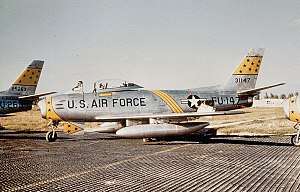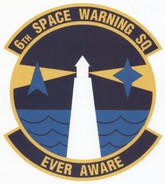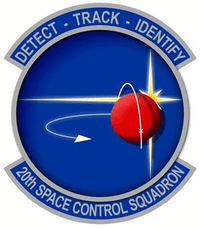21st Operations Group
The 21st Operations Group (21 OG) was an operations group of the United States Space Force. It was assigned to the 21st Space Wing, stationed at Peterson Air Force Base, Colorado. It was responsible for ground-based missile warning, space control operations. It provided real-time missile warning, attack assessment, and space control. The 21 OG was also responsible for the development of future counterspace capabilities and was the most geographically dispersed operations group in the Space Force.[6]
| 21st Operations Group | |
|---|---|
| Active | 13 January 1942–24 July 2020 [1] |
| Country | |
| Branch | |
| Type | Operations group |
| Role | Missile warning and space control[2] |
| Part of | |
| Headquarters | Peterson Air Force Base, Colorado, U.S. |
| Engagements | |
| Decorations | Air Force Outstanding Unit Award[4] |
| Commanders | |
| Commander | Col Matthew S. Cantore [5] |
World War II




- For additional history and lineage see 21st Space Wing
Constituted as 21st Bombardment Group (Medium) on 13 January 1942. Activated on 1 February 1942 at Bowman Field, Kentucky. Thereafter, from February 1942 until October 1943, the group relocated successively to Jackson Army Air Base; Mississippi; Columbia Army Air Base, South Carolina; Key Field, Mississippi, and MacDill Field, Florida.
The 21st initially trained on B-25 Mitchell bombers then converted to B-26 Marauders. The group largely served as an operational training unit assigned to Third Air Force; however, while at MacDill Field, from June 1942 to October 1943, the 21st additionally carried out antisubmarine patrols over the Caribbean Sea. For this action the group received the Antisubmarine 1941–1945 campaign streamer. The 21st inactivated on 10 October 1943.
The 21st did not have to wait long to write a further chapter in the history of warfare. Another unit, the 21st Fighter Group (FG), activated on 21 April 1944 at Wheeler Army Airfield in the Hawaii Territory. Assigned to VII Fighter Command, the group consisted of the 46th, 72d, and 531st Fighter Squadrons. Over the next two months, the group trained on its first aircraft type, the P-39Q Airacobra. The 21st provided air defense over the Hawaiian Islands from July 1944, then began upgrading into the P-38J/L Lightning in September.
By the end of October, rumors filled the air that the group soon would upgrade airframes again, this time to the P-51 Mustang. This change in aircraft heralded a new mission for the 21 FG. True to rumor, leading echelons began deploying by ship to the island of Iwo Jima in the western Pacific in February 1945.
Before the end of the month, the 21st began flying patrols over the critical island base in support of ground operations. The final group echelon arrived at Iwo Jima on 25 March. Early the next morning, elements of the 21st were attacked in their encampment by Japanese soldiers. Assisted by a patrol of American Marines, 21st personnel counterattacked and in the tent-by-tent fighting killed 250 of the enemy. Fourteen group personnel were killed and 50, including 21 FG commander Colonel Kenneth R. Powell, were wounded.
The first long-range aerial mission of the 21st Fighter Group against the mainland of Japan began on 7 April 1945, when the group's Mustangs escorted a formation of B-29 bombers against the fortified and well-defended Nakajima aircraft factory near Tokyo. This mission marked the first time fighters had escorted bombers over Japan. Moreover, this mission has been credited as having been the longest over-water fighter escort sortie to date. Over the following weeks, the 21st escorted American B-29s over enemy airfields and industrial targets and engaged rival Japanese fighter aircraft. The 531st Squadron achieved another first for the 21 FG in June 1945 by initiating aerial rocket strike sorties against select enemy targets which included ships and a radio station. In the meantime, the groups' aircraft continued to duel in the air and two "aces" soon emerged: Major Harry Crim and Captain Willis Matthews, both of the 531st Fighter Squadron. Aircrews of the 21st also strafed the airfields which the Japanese used for their increasingly dangerous kamikaze attacks. The 21 FG flew its last combat mission 14 August 1945, about two weeks before the official Japanese capitulation on 2 September.
The group received the Distinguished Unit Citation on 13 November 1945 specifically for its outstanding conduct during the earlier raid on Nakajima. However, the 21st had played a laudable part throughout the final stages of the war in the Pacific.
After the war, the group transferred from Iwo Jima, first to Saipan, then finally to Guam. Re-equipped with P-47 Thunderbolts during the summer of 1946. The 21 FG inactivated on 10 October 1946.
The 1950s and after


Redesignated 21st Fighter-Bomber Group. Activated at George AFB California on 1 January 1953 with three (72d, 416th and 531st) Fighter-Bomber squadrons. Assigned to Tactical Air Command. Equipped for a few months with F-51's, later with F-86's. Maintained tactical proficiency and provided air defense augmentation in the United States, January 1953 – November 1954.
At George, the group established and maintained tactical proficiency and provided air defense augmentation. In December 1954, the group was assigned to NATO and was reassigned to Chambley-Bussieres Air Base, France.
The 21 FBG consisted of three squadrons, the 72d, 416th and 531st Fighter-Bomber Squadrons, equipped with the F-86F Sabre. Upon their arrival, the facilities at Chambley were not ready for aircraft use, and the squadrons had to deploy elsewhere. The 72d deployed to Chateauroux AB, while the 416th and 531st operated out of Toul-Rosieres AB.
After many construction delays, the group combined its fighter squadrons at Chambley on 15 April 1955. The squadrons carried out close air support training missions with the Army, then took first place at the United States Air Forces in Europe (USAFE) "Gunnery Meet" at Wheelus Air Base, Libya.
The 21 FBW participated in the Atomic Warfare exercise Carte Blanche, and went on to take an overall second place in the Nellis AFB, Nevada Gunnery Meet in 1956. Moreover, they won the USAFE Award for Tactical Proficiency for the January–June period of 1957.
In 1957, the French Government decreed that all nuclear weapons and delivery aircraft had to be removed from French soil by July 1958. As a result, the F-86's of the 21st Fighter-Bomber Group had to be removed from France. During October 1957 it was announced that the 21 FBG would be inactivated on 8 February 1958, and that its assets would be dispersed among existing USAFE units.
After 1991
In 1991, the 21st Tactical Fighter Wing was reorganized as an objective wing and all the major tenant units on Elmendorf AFB, Alaska were placed under it. The 21st Operations Group was the flying component of the 21st Wing. The 21st Wing was inactivated and the 3d Wing was reassigned from Clark Air Base, Philippines to Elmendorf on 19 December 1991 as a result of the Mount Pinatubo eruption and the inhabitability of Clark. This was in keeping Air Force's policies of retaining the oldest and most illustrious units.
The 21st Operations Group was reactivated on 15 May 1992 as a component of the redesignated and reactivated 21st Space Wing, commanding Air Force Space Command's worldwide network of assigned missile warning, space surveillance, and communications units.
Units circa 2019






- Detachment 1, 20th Space Control Squadron, White Sands Missile Range
- Detachment 2, 20th Space Control Squadron, Naval Support Facility Diego Garcia
- Detachment 3, 20th Space Control Squadron, Air Force Maui Optical and Supercomputing observatory
Lineage
21st Bombardment Group
- Constituted as 21st Bombardment Group (Medium) on 13 January 1942
- Activated on 1 February 1942
- Disbanded on 10 October 1943
- Reconstituted and consolidated with the 21st Fighter Group on 31 July 1985 as the 21st Tactical Fighter Group[8]
21st Fighter Group
- Constituted on 31 March 1944
- Activated on 21 April 1944
- Inactivated on 10 October 1946
- Redesignated 21st Fighter-Bomber Group on 15 November 1952
- Activated on 1 January 1953
- Inactivated on 8 February 1958
- Consolidated with the 21st Bombardment Group as the 21st Tactical Fighter Group[8] (Remained inactive)
- Redesignated: 21st Operations Group on 25 September 1991
- Activated on 26 September 1991
- Inactivated on 19 December 1991
- Activated on 15 May 1992.
Assignments
|
|
Components (not including space units)
- 8th Reconnaissance (later, 398th Bombardment) Squadron: attached 1 February – 21 April 1942, assigned 22 April 1942 – 10 October 1943
- 313th Bombardment Squadron: 1 February 1942 – 10 October 1943
- 314th Bombardment Squadron: 1 February 1942 – 10 October 1943
- 315th Bombardment Squadron: 1 February 1942 – 10 October 1943
- 46th Fighter Squadron: 15 June 1944 – 10 October 1946
- 72d Fighter (later, 72d Fighter-Bomber) Squadron: 15 June 1944 – 10 October 1946; 1 January 1953 – 8 February 1958 (detached 27 August – 17 September 1953 and 15 April 1957 – 8 February 1958)
- 531st Fighter (later, 531st Fighter-Bomber) Squadron: 15 June 1944 – 10 October 1946; 1 January 1953 – 8 February 1958 (detached 26 September-c. 17 October 1953 and 15 April 1957 – 8 February 1958)
- 416th Fighter-Bomber Squadron: 1 January 1953 – 8 February 1958 (detached 12 September-c. 2 October 1953 and 15 April 1957 – 8 February 1958)
- 90th Fighter Squadron: 26 September – 19 December 1991
- 43d Fighter Squadron: 26 September – 19 December 1991
- 54th Fighter Squadron: 26 September – 19 December 1991
- 21st Crew Training Squadron: 15 May 1992 – 1 October 1994
Stations
|
|
Aircraft
|
|
List of commanders
|
|
Notes and references
- https://www.spaceforce.mil/News/Article/2287005/space-force-begins-transition-into-field-organizational-structure
- https://www.peterson.af.mil/About/Welcome-to-the-21st-Space-Wing/
- https://www.afhra.af.mil/About-Us/Fact-Sheets/Display/Article/434123/21-operations-group-afspc/
- https://www.afhra.af.mil/About-Us/Fact-Sheets/Display/Article/434123/21-operations-group-afspc/
- https://www.peterson.af.mil/About/Biographies/
- https://www.peterson.af.mil/Units/21stOG/
- https://www.peterson.af.mil/Units/
- Department of the Air Force/MPM Letter 648q, 31 July 1985, Subject: Reconstitution, Redesignation, and Consolidation of Selected Air Force Organizations
- https://www.afhra.af.mil/About-Us/Fact-Sheets/Display/Article/434123/21-operations-group-afspc/
![]()
- Maurer, Maurer (1983). Air Force Combat Units of World War II. Maxwell AFB, Alabama: Office of Air Force History. ISBN 0-89201-092-4.
- 21st Space Wing website

.svg.png)
.png)
.svg.png)